 Every spinning mill needs to invest to maintain its competitive edge. Keeping pace with latest technology is paramount – but too much emphasis on the actual production machines can also be risky, especially if the spinner fails to protect a new investment adequately.
Every spinning mill needs to invest to maintain its competitive edge. Keeping pace with latest technology is paramount – but too much emphasis on the actual production machines can also be risky, especially if the spinner fails to protect a new investment adequately.
Expensive production machinery such as cards and spinning frames can easily be damaged, for example, by metal pieces caught up in the fibers. The resulting impact in terms of downtime and substandard yarn quality can be disastrous – and costly. Reliable detection and removal of metallic fragments with the USTER® JOSSI METAL SHIELD is a sure way to safeguard both capital investments and profitable production of quality yarn.
Imagine this scenario, a typical one in many spinning mills. The mill manager notices irregularities in nep values when lab-testing samples with the USTER® AFIS PRO 2. With a nep level 50% higher than expected, it’s likely that the fault originated at the carding machine. There is even a strong suspicion that damaged card clothing is the cause.
The quality alert sets off a chain of events: the cards are stopped and inspected; the damaged component is identified; spare parts are ordered from the service agent, and a repair is carried out. The machine is restarted and production is back to normal – albeit with a total bill for this single incident amounting to some USD 10,000. And that’s only part of the story…
In this example, the problem in the card was caused by a metal piece being transported and forwarded with the cotton tufts. It could have caused some damage in earlier processes, but in this case it was the carding machine, which came off worst, with some of the fine and precisely aligned teeth of the clothing being damaged or broken off entirely.
This kind of incident is most often seen in spinning mills, which choose to target investments largely at production-related equipment. It’s a policy, which doesn’t find room for systems to detect and eliminate metal pieces in the cotton. Yet, when production machines are damaged, it’s clear that efficiency and quality also suffer – two of the most important business success factors for both productivity and profitability!
Bad luck has many chances to strike…
How do these metal pieces actually get into the mill in the first place, and where do they come from? They could be screws, nuts, travelers, pieces of wire or metallic bale strapping, even parts of old or badly maintained machinery. They might find their way into the cotton in various manners: at loading and transport of the seed cotton; in the gin; or even in the spinning mill itself. Anything carelessly dropped on the floor in these situations could be swept up and entangled with the cotton – even in the tidiest of mill environments.
In fact, no matter how or where it happens, metal pieces must not get into raw cotton being processed for yarn. A spinning mill contains far too many high-speed, high-precision and expensive machines to put any at risk of damage. Carding machines are obviously in this category, as are both coarse and fine cleaners.
The best protection method available to a mill is to install an instrument for metal detection and elimination shortly after the bale opener. A daily average of 10 to 20 metal pieces is taken out of the yarn production process in this way, but the figure can sometimes reach up to 50. That means the instrument’s diverter mechanism opens as many as 50 times a day, each time sending the raw material stream containing the detected metal piece safely along a side channel for disposal.
Technical advantages, bigger savings
Spinners are, of course, aware that this kind of procedure leads to wasted raw material. With conventional instruments of this type, the diverter opens for three seconds at each detection – so a total of 90 seconds per day with 30 incidents. This produces 20 kg of wasted cotton, worth at least USD 24 today.
The USTER® JOSSI METAL SHIELD, however, has a number of exclusive technical advantages which would, in the same example, result in only 2 kg of waste, at a cost of USD 2.40. A key feature is its use of inductive sensors, which not only detect the metal piece but, at the same time, measure its mass and speed. Based on this, the opening time of the diverter is adapted, in a range from 0.2 to 3 seconds. Since only one in 30 metal pieces requires the diverter to open for the full 3 seconds, the shorter total opening time and the ensuing savings improve the mill’s profitability. Thanks to this feature, known as Speedsense, the USTER® JOSSI METAL SHIELD typically brings a cost reduction of more than USD 7,000 per year in practical examples.
Protecting profitability, all along the line
Going back to our initial scenario, with the mill manager checking lab test results, we might take the story on a little further. After one day, in an ideal case, the damaged carding machine would be fixed – and maybe cost of the repair and the production downtime during this time would soon be forgotten. However, what should not be forgotten here is that the production now certainly contains some off-quality yarn. During all the time the damaged card was running, there were continuous irregularities with neps and short fiber content, while yarn evenness was also negatively influenced. Further on at the winding room, where yarn clearers monitor 100% of production, the spinning mill’s overall efficiency and profitability would have been hit again, with every clearer cut adding to the cost.
An investment to protect investments, the USTER® JOSSI METAL SHIELD safeguards vital production machines – with the extra insurance for mill efficiency and profitability to defend tight margins in the volatile business environment.
 Tekstil Teknik Dergisi Tekstil Haberleri, Tekstil Sektörü, Tekstil Teknik
Tekstil Teknik Dergisi Tekstil Haberleri, Tekstil Sektörü, Tekstil Teknik




